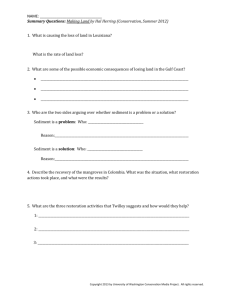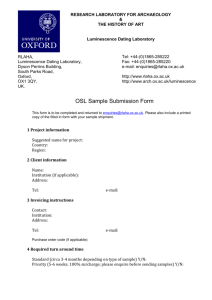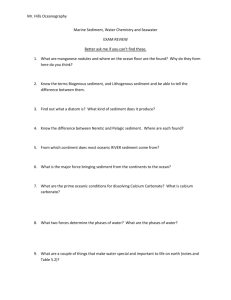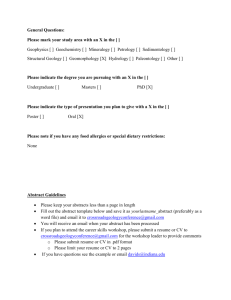3798rowenotes
advertisement
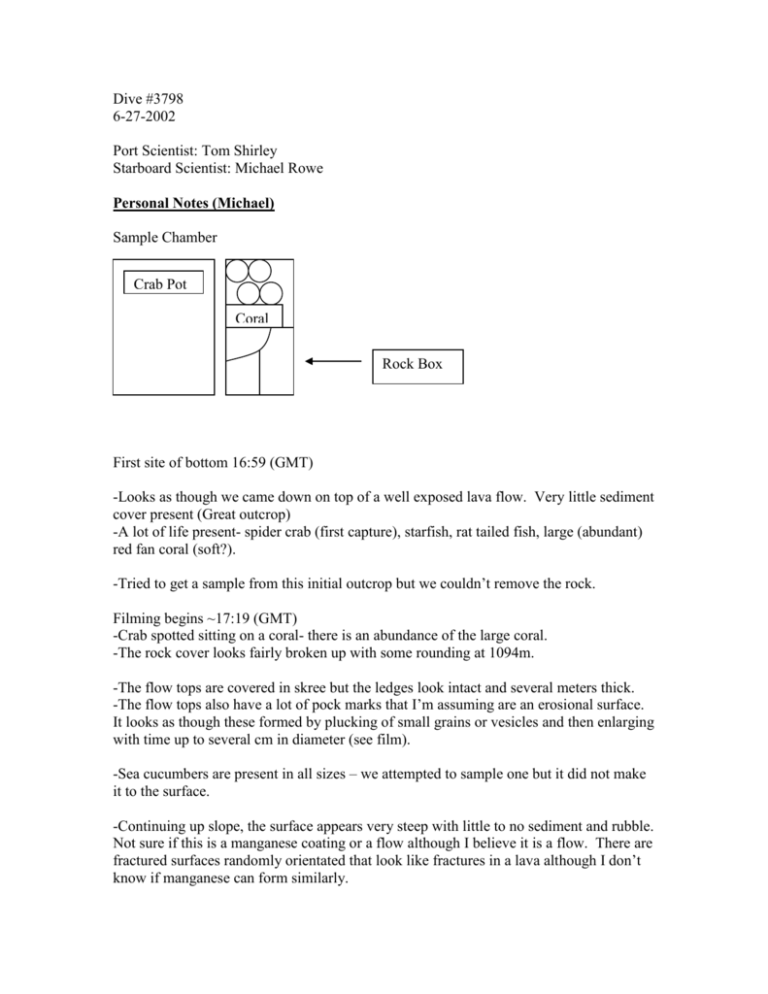
Dive #3798 6-27-2002 Port Scientist: Tom Shirley Starboard Scientist: Michael Rowe Personal Notes (Michael) Sample Chamber Crab Pot Coral Rock Box First site of bottom 16:59 (GMT) -Looks as though we came down on top of a well exposed lava flow. Very little sediment cover present (Great outcrop) -A lot of life present- spider crab (first capture), starfish, rat tailed fish, large (abundant) red fan coral (soft?). -Tried to get a sample from this initial outcrop but we couldn’t remove the rock. Filming begins ~17:19 (GMT) -Crab spotted sitting on a coral- there is an abundance of the large coral. -The rock cover looks fairly broken up with some rounding at 1094m. -The flow tops are covered in skree but the ledges look intact and several meters thick. -The flow tops also have a lot of pock marks that I’m assuming are an erosional surface. It looks as though these formed by plucking of small grains or vesicles and then enlarging with time up to several cm in diameter (see film). -Sea cucumbers are present in all sizes – we attempted to sample one but it did not make it to the surface. -Continuing up slope, the surface appears very steep with little to no sediment and rubble. Not sure if this is a manganese coating or a flow although I believe it is a flow. There are fractured surfaces randomly orientated that look like fractures in a lava although I don’t know if manganese can form similarly. -Some very large yellow sponges and yellow sponges that you can see down into. Also some tubes present. -Squat lobsters seem to be concentrated on the soft red corals. -Abundant shrimp in the water, several small squid. -Fine white dots appear on the surface. They appear to be organic but I cannot identify them-998m. -Leveling off at 984m. It appears that we are traveling along a ledge top and that we have been working up one side of the ledge. There is an increase in sediment at the top of the ledge. 18:28 (GMT) -We have continued over the ridge and are dropping back down the other side. It is quite a drop. -We are unsure as to which way to go to get to the seamount. If our positioning was correct then we should have had a slight drop as we came over the ridge and then the bottom should have risen again as we came up on the next ridge but the bottom seems to still be dropping and is ~100m below us (much lower than original depth). 19:04 -Bottom relocated -Slope has a lot of loose sediment composed of a finer sand/silt with sub-rounded to rounded clasts that appear to be slightly different colors (compositions?). -Very little biological material on this slope as well. -Continuing up slope (995m). The ground cover becomes more coherent with larger blocks of rock, less rounded, and less sediment. -First king crab at 955m. -The topography is really rough. It is difficult to follow on the map, we keep going over the ridge. I think if we stay on a ridge and follow that line we should end up at the top. -Flow structures in the lava are present away from the peak. Is this a small vent? -Following up a valley? The bottom slopes up to the starboard side with fairly thick sediment cover. It is a mixture of the finer sand and pebbles. It is difficult to determine if it is just coming down off of the slope. 20:35 -Push cores taken X=2656; Y=12308, D=936m -Turns out to be a relatively thin layer of sediment (~3inches) before the push core hits a hard surface. -Begin to see a couple of crab species. Look for crab vs. claw standoff on film (20:54). -Coral collecting from a large outcrop-vertical face, that appears up out of the valley floor. The flow appears to be dipping somewhat towards us. A couple of saber fish (or black cod) were present at shallower depths. -King crab off of bottom at 21:34. The crab do not appear to be as abundant on this softer sediment. They begin to reappear when the bottom begins to become slightly more rocky again. I’m not sure if this is due to the sediment bottom or if it is do to the lack of corals present. -Continuing up the valley I get a good cross sectional view of the thin floor. There is a thin layer (several inches at the most) of fine sediment with subrounded pebble sized clasts. Below that thin layer there is what appears to be a thin flow (6-8inches??) and relatively continuous upslope. -King crab at 22:04 -Water samples taken at 718m 22:15 Terrane changes. The bottom becomes rockier. The clasts are much more angular and larger with less of the fine sediment cover. There is a corresponding increase in the biological diversity with more coral becoming evident ~700m. Final Location: X=2528; Y=13129; D=670




